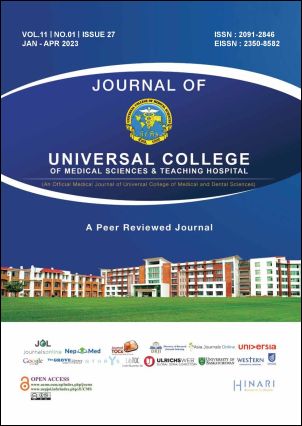Indications of Root Canal Treatment for Patients Visiting Tertiary Care Hospital: A Hospital Based Prospective Study
DOI:
https://doi.org/10.3126/jucms.v11i01.54640Keywords:
Diagnosis, Patients, Root canal treatmentAbstract
INTRODUCTION
Root Canal Treatment (RCT) when an irreversibly damaged or necrotic pulp with or without clinical and/or radiological findings of apical periodontitis occur. Apart from these there are various other reasons in which RCT is performed. There is paucity of literature revealing diseases requiring RCT and what are the presenting symptoms for patients requiring it. Hence, this study is conducted to overview the factors for it.
MATERIAL AND METHODS
Among 594 patients, 510 were included in the study. The survey form included patient specific characteristics such as: age, gender, tooth number and pain; tooth specific characteristic included swelling, previous root canal treatment, complain tooth characteristic, diagnosis and tooth wear. These data were matched with the respective radiograph and history form sheet. Two observers participated in collection of data in the study. Inter-observer agreement was tested with Cronbach’s alpha which was 0.79. The data were collected in a spreadsheet and simple descriptive statistical analysis was performed using SPSS software version 22 to get the results in percentages and frequencies.
RESULTS
54.1% of female patients had undergone RCT and 75.7% of patients presented with pain. The most common treated tooth was first molar. The most common pulpal diagnosis was symptomatic irreversible pulpitis (36.08%, n=184) followed by pulp necrosis (30.20%, n=154) and previously treated (17.25%, n=88). The most common periapical diagnosis was symptomatic apical periodontitis (62.94%, n=321).
CONCLUSION
Subjective symptoms were the most common factor for seeking treatment. Hence, a greater number of awareness campaign are required to acknowledge asymptomatic cases too.
Downloads
Downloads
Published
How to Cite
Issue
Section
License
Copyright (c) 2023 Journal of Universal College of Medical Sciences

This work is licensed under a Creative Commons Attribution-NonCommercial 4.0 International License.
Authors have to give the following undertakings along with their article:
- I/we declare that this article is original and has not been submitted to another journal for publication.
- I/we declare that I/we surrender all the rights to the editor of the journal and if published will be the property of the journal and we will not publish it anywhere else, in full or part, without the permission of the Chief Editor.
- Institutional ethical and research committee clearance certificate from the institution where work/research was done, is required to be submitted.
- Articles in the Journal are Open Access articles published under the Creative Commons CC BY-NC License (https://creativecommons.org/licenses/by-nc/4.0/)
- This license permits use, distribution and reproduction in any medium, provided the original work is properly cited, and it is not used for commercial purposes.




